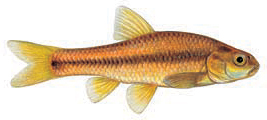
Fishes are ectothermic vertebrates, living in water, breathing by means of gills and having fins for stability and movement. Most of those described in this chapter are confined to inland waters; however, the eels (Anguilla) breed in the ocean and the young migrate into rivers to mature.
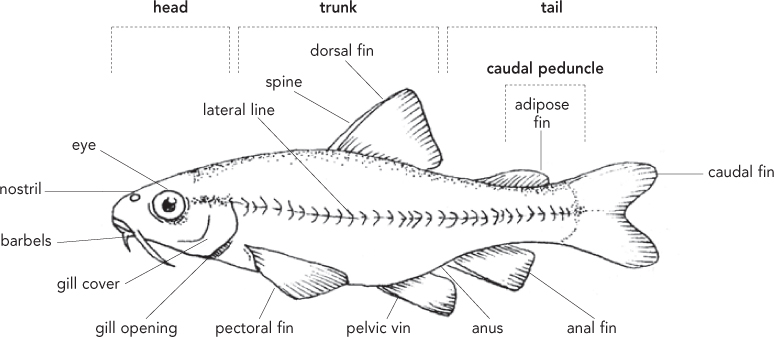
The body of a fish consists of a head, trunk and tail. The head, which bears the eyes, nostrils, mouth and gills, is measured from the snout to the end of the gill covers. The trunk comprises the body from behind the head to the anus or start of the anal fin. The tail region is taken from the anal fin to the end of the caudal fin. The caudal peduncle is the flexible region from the hind end of the anal fin to the base of the caudal fin.
Mucus is secreted from the skin to provide a friction-reducing layer, for protection against diseases and parasites, for initial healing of wounds and, in many cases, as toxic secretions for defence against predators.
Scales consist of a bony plate covered by a thin layer of skin. They protect the body and sometimes have an ornamental function. Bony scales increase in size by adding concentric outer layers. The pattern of these growth rings indicates the age of a fish. There are different kinds of scales: cycloid scales are simple and round or ovoid in shape; ctenoid scales have fine teeth on the free edge.
Fins are either paired (pectoral and pelvic fins) or lie in the midline (dorsal, caudal and anal fins). Fins are supported by spines and soft rays. Spines may have barbs along the edges. The spines of many catfishes can be held erect by means of a locking mechanism, and form an effective defence. Soft rays are divided into two halves and are segmented; they may be simple or branched.
Many fishes have a second dorsal fin, the adipose fin, which may be small and lobate like that of a trout, or large and firm like that of the vundu. Fins perform a variety of functions: producing and controlling movement, defence, display and communication. Their shape, size and position are important identifying characters.
In many fishes the upper and lower jaws can both be moved and the mouth actively protruded during feeding. The lips indicate the feeding style of the species. Fishes that scrape their food from firm surfaces have firm sharp lips, grubbers have large soft lips, predators have thin lips that may cushion the teeth but allow them to be exposed when feeding. Some fishes, e.g. the yellowfishes which have a wide range of feeding habits, are able to develop different forms of lip, depending on the circumstances.
The lateral line is a system of sensory organs that detect water currents and moving bodies close to the fish. It is prominent in actively swimming and schooling fishes and may be absent from more sedentary species.
About 245 species of fishes have been recorded in the inland waters of southern Africa, excluding several marine species that have been found sporadically in the lower reaches of rivers. This chapter deals with about 150 species, representing the main groups likely to be encountered.
The inland waters of southern Africa can be subdivided into aquatic ecoregions (see map on p. 4), each with a typical fish fauna. The river systems mentioned in species descriptions in this chapter are also shown on the map:
• Tropical east coast region. A diverse range of fishes occur here, including large species such as the cornish jack and lungfish, barbs and labeos, the tigerfish and imbreri, annual killifishes, several important cichlid species such as the Mozambique tilapia, and climbing perch species. Eels are also present.
• Tropical interior region. The fishes of this region are the most diverse in southern Africa but there are several notable species absent or excluded by waterfalls, such as the Victoria Falls. Characteristic fishes include groups of catfishes such as squeakers and air-breathing catfishes. There are also a number of large cichlids, including largemouth breams, tilapias, riverine dwarf breams, robbers and the tigerfish. The African pike is a noteworthy species of the area. The bulldog and similar species are most common here. Notable species that do not occur are the lungfish, eels, the cornish jack, the electric catfish and the vundu.
• Highveld (temperate) region. The fish fauna of this region is relatively poor with a few yellowfish species and one or two minnow and labeo species predominating. The more tropical fishes are either absent or represented by one or two species only. Carp is the most prominent alien species in the region.
• Montane escarpment region. Smaller flowing-water species such as mountain catfishes, suckermouth catfishes, eels, a few barbs and knerias are characteristic of these waters.
• Cape fold mountain region. Redfin minnows, the Cape galaxias, Cape kurper and, in certain rivers, larger cyprinids such as the sawfin and whitefish are characteristic.
• Kalahari-Karoo-Namib region. A few hardy species tolerant of fluctuating environments are found here, e.g. the sharptooth catfish, smallmouth yellowfish, moggel and chubbyhead barb. Carp also occur in most rivers.
Males of some species, especially the cichlids (breams, tilapias and others), acquire bright colours during the breeding season and use these, together with ritual movements, to attract females. Eggs are laid by the female and the male deposits sperm over them. Several species clear nesting depressions in the bottom sediments, and guard the territory and eggs from intruders. Females of the mouthbrooding species scoop their eggs into the mouth for safekeeping, once they are fertilised.
Annual killifishes have adapted to live in temporary pans. During the wet season, eggs hatch and mature into adulthood in a matter or weeks. The adults lay new eggs and die when the pan dries up. The eggs remain dormant until the pan refills the following year.
Eels breed at sea and the leaf-like larvae metamorphose into transparent “glass eels” and move into estuaries. After some time they change again into elvers and migrate further upstream. Here they remain and mature for 10 or 20 years before returning to the sea to breed.
The dimensions given with the illustrations of fishes refer to the total length from the front of the head to the end of the tail.
1 LUNGFISH

Greyish-brown with dark brown spots and blotches. Body is elongated, tapered to a point, pectoral and pelvic fins slender, tapered. Airbreathing lung enables it to live in poorly oxygenated pans, swamps. During droughts, it forms a burrow in soft sediments and secretes a mucous cocoon in which it lies dormant, breathing through a small opening. Middle Zambezi valley, Mozambique coastal plains southwards to Incomati River.
Mormyrops anguilloides
2 CORNISH JACK

Grey above, silvery white below, often with bronze or yellow sheen. Head and body elongated, dorsal and anal fins set well back, dorsal shorter than anal. Prefers deep, quiet water. Middle and lower Zambezi, Buzi and Pungwe rivers.
Marcusenius macrolepidotus
3 BULLDOG
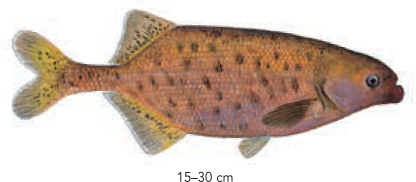
Light golden brown to dark olive and grey with bronze flecks and dark brown blotches. Dorsal and anal fins set well back, prominent lobe on lower jaw. Shoals in margins of rivers, floodplains. Middle and lower Zambezi, Pungwe and Buzi rivers. A similar species, (M. altisambesi), is found in Cunene, Okavango and Upper Zambezi, and another, M. pongolensis, occurs in rivers from the Limpopo south to Umhlatuzi.
Similar
SLENDER STONEBASHER Hippopotamyrus ansorgii
Smaller. Dark brown or black, vertical bar from dorsal origin. Cunene, upper Zambezi, Okavango, Buzi, Pungwe rivers.
ZAMBEZI PARROTFISH H. discorhynchus
Greyish-brown to nearly black. Cunene, Okavango, Zambezi, Buzi, Pungwe rivers.
Anguilla mossambica
4 LONGFIN EEL
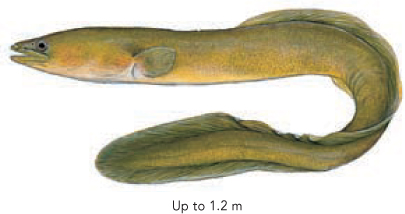
Long, smooth-skinned, snake-like form. Dorsal fin begins ahead of anal fin. Olive-brown or grey, lighter below; on maturity, prior to entering sea, colour changes to dark bronze above and light yellow below. East coast rivers to Cape Agulhas.
Similar
SHORTFIN EEL A. bicolor bicolor
Dark olive-brown above, pale below; mature adult changes to bronzy silver. Beginning of dorsal/anal fins opposite.
AFRICAN MOTTLED EEL A. bengalensis labiata
Yellowish-brown, mottled with dark brown or black. Uncommon south of Save River.
GIANT MOTTLED EEL A. marmorata
Mottled yellow and dark brown or black. More common south of Limpopo River.
Mastacembelus frenatus
5 LONGTAIL SPINY EEL
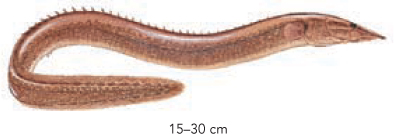
Brown; pattern of fine markings may form “eye-spots” on tail. Short spines along back. Vegetation along margins of flowing rivers; also rocky crevices. Upper Zambezi, Okavango rivers.
Similar
OCELLATED SPINY EEL M. vanderwaali
Mottled dark brown and yellow. Larger head.
1 BREEDE RIVER REDFIN
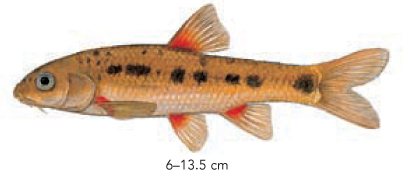
Juvenile and young adult olive-brown with scattered spots and blotches, an irregular stripe expanding into triangle at base of tail. Breeding adult deepens to dark olive-brown, lighter underneath, with scarlet patches at base of fins. Pools and deeper-flowing stretches of Breede River and adjacent systems.
Similar
Six more species, five from Cape fold mountains and one from Drakensberg, 7-13 cm, recognisable by their scarlet fin bases. All are threatened: two endangered, two critically endangered.
Barbus anoplus
2 CHUBBYHEAD BARB
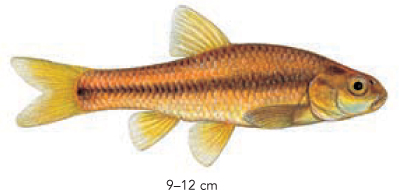
Breeding male golden in summer; female and non-breeding male greyish-green above with small dot at base of caudal fin. Prefers cooler waters in various habitats from small streams to large lakes; often in cover of fallen logs or marginal vegetation. Highveld reaches of Limpopo River through east to southwest (east of fold mountains), middle and upper Orange basin and Karoo.
Similar
REDTAIL BARB B. gurneyi
East, from Umtamvuna to Amatikulu.
MARICO BARB B. motebensis
Southern highveld tributaries of Limpopo River.
AMATOLA BARB B. amatolicus
Kei and Mbashe systems.
Barbus annectens
3 BROADSTRIPED BARB
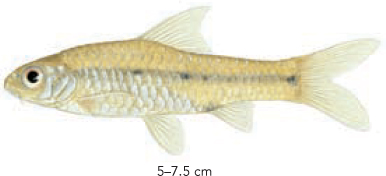
Translucent olive-brown with either three spots or broad dark band along body, dark spot at base of anal fin. Favours slow-flowing streams with vegetation. East coast rivers from Zambezi system to Mkuze, lowveld south of Limpopo River.
Similar
BAROTSE BARB B. barotseensis
Cunene and Okavango systems.
Barbus lineomaculatus
4 LINE-SPOTTED BARB
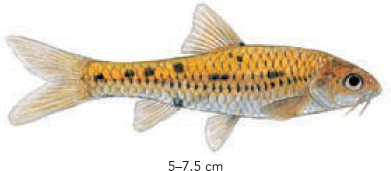
Translucent brown with variable dark spots along body, lateral line scales with prominent chevron bars. Small streams to large rivers. Spawns upstream in flooded grassy areas. Cunene, Okavango, Zambezi, Limpopo river systems.
Barbus pallidus
5 GOLDIE BARB
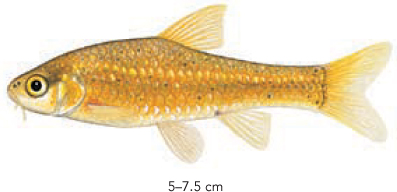
Translucent light brown above, silvery on sides and below; breeding male turns bright golden. Favours pools in clear, rocky streams with emergent vegetation. Coastal streams of the southeast from Great Fish to Krom; tributaries of Vaal, Limpopo, Tugela, Pongolo rivers.
Similar
SHORTFIN BARB B. brevipinnis
Dashes or stripe along midbody. Sabie-Incomati and Steelpoort-Limpopo river systems.
SIDESPOT BARB B. neefi
Large dark spots along body. Tributaries of Steelpoort-Limpopo.
1 LONGBEARD BARB
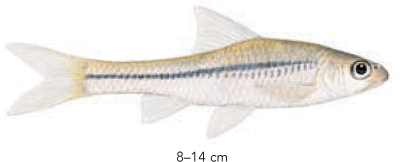
Translucent brown with silvery white below, dark lateral stripe and chevron markings on lateral line. Two pairs of long barbels. Flowing and standing waters, thrives in dams and lakes. Cunene, Okavango and Zambezi southwards to Pongolo rivers.
Similar
BEIRA BARB B. radiatus
Stripe passes through eye, barbels short.
Barbus bifrenatus
2 HYPHEN BARB
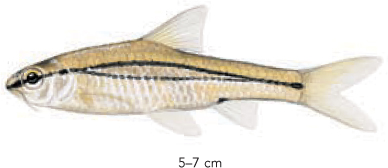
Translucent brown, silvery white on sides and below. Black stripe from tip of snout through eye to end of caudal peduncle, lateral line marked by black. Floodplains, pools, shallow streams with vegetation. Cunene, upper Zambezi, Okavango, Limpopo systems and St Lucia.
Similar
BOWSTRIPE BARB B. viviparus
Black stripe from behind head ends in spot at base of tail. Eastern coastal rivers and lakes southwards to Vungu River. BLACKBACK BARB B. barnardi
Irregular black spots along midline of back. Cunene, Kafue, upper Zambezi, Okavango systems.
EAST COAST BARB B. toppini
Smaller (3–4 cm). East coast southwards to Mkuze system.
BROADBAND BARB B. macrotaenia
Smaller (3–4 cm). Lower Zambezi, Pungwe rivers.
Barbus haasianus
3 SICKLE-FIN BARB
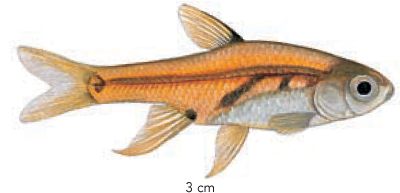
Translucent brown to rosy red (breeding male). Sickle-shape anal fin in mature male. Swamps and floodplains of Okavango, upper and lower Zambezi, Pungwe rivers.
Barbus fasciolatus
4 RED BARB
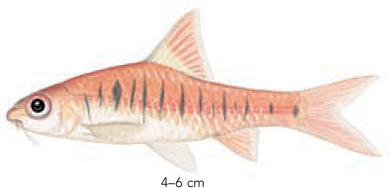
Light rose to red, silvery below; 10-15 black vertical bars on body. Favours well-oxygenated floodplain river channels and lagoons. Cunene, Okavango, upper and middle Zambezi rivers.
Barbus trimaculatus
5 THREESPOT BARB
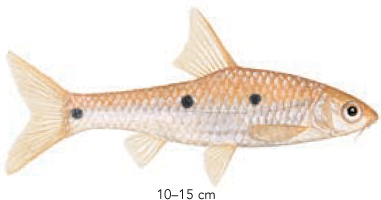
Silvery, tinged with gold when in breeding condition; usually three clear black spots on body and base of tail. Spine in dorsal fin. Hardy, common. East coast southwards to Umvoti, also Orange, Cunene systems.
Similar
DASHTAIL BARB B. poechii
Oblong black dash at base of tail. Cunene, Okavango rivers.
Barbus calidus
6 CLANWILLIAM REDFIN
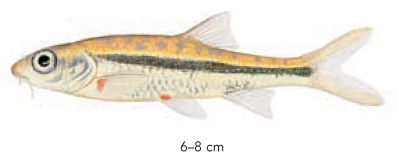
Brown above, silvery white below, with broad dark band along body, irregular dark blotches along back. Serrated spine in dorsal fin. Large, deep pools in clear streams. Tributaries of Clanwilliam Olifants rivers in the southwest. Endangered.
Similar
TWEE RIVER REDFIN B. erubescens
Breeding male turns red. Twee River in southwest. Critically endangered.
1 STRAIGHTFIN BARB
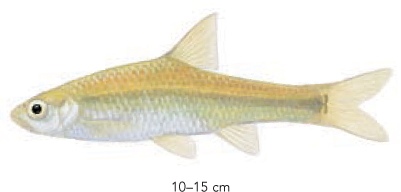
Plain olive-grey or silvery in turbid waters. Dorsal fin with serrated spine, hind margin vertical; two pairs short barbels. Prefers quiet, well-vegetated waters. East coast rivers southwards to Vungu. Also Cunene, Okavango, Orange rivers.
Similar
NAMAQUA BARB B. hospes
Pale silvery or white. Orange River below Augrabies Falls.
BORDER BARB B. trevelyani
Translucent grey-brown. Keiskamma and Buffalo systems in southeast. Critically endangered.
YELLOW BARB B. manicensis
Plain silvery. Pungwe, Buzi, lower Zambezi in Mozambique.
Barbus afrovernayi
2 SPOTTAIL BARB
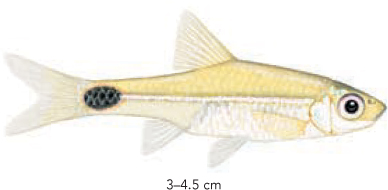
Translucent grey-brown with iridescent lilac-yellow stripe along body, silvery below; large black spot on caudal peduncle. Quiet, well-vegetated water. Cunene, upper Zambezi, Okavango rivers.
Barbus eutaenia
3 ORANGEFIN BARB
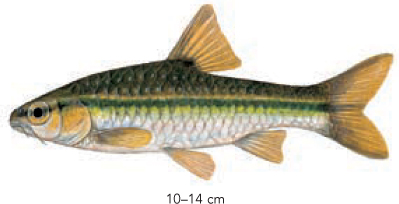
Olive above, silvery white below, fins yellow or orange; broad black band runs from snout through mid-caudal fin. Prefers clear-flowing waters with rocky habitats. Cunene, Okavango rivers, and east coast systems southwards to Incomati River.
Similar
ZIGZAG BARB B. miolepis
Deeper body, more robust head, smaller eye. Okavango River.
COPPERSTRIPE BARB B. multilineatus
Breeding male has copper stripe along body through tail. Cunene, Okavango, upper and middle Zambezi rivers.
REDSPOT BARB B. kerstenii
Yellow, orange or red spot on gill covers. Cunene, Okavango, upper and lower Zambezi, Save and Runde systems.
Barbus mattozi
4 PAPERMOUTH
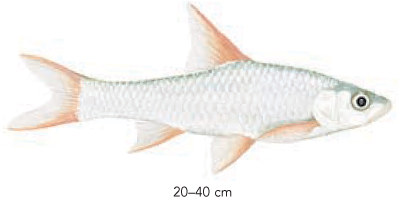
Silvery with orange fins. Large pools in perennial rivers, also thrives in dams. Larger individuals are valued angling targets. Limpopo system, headwaters of Gwai (Zimbabwe), Cunene rivers.
Similar
ROSEFIN BARB B. argenteus
Fins orange-red. Incomati and Pongolo rivers.
PLUMP BARB B. afrohamiltoni
Silvery. Lowveld reaches of east coast rivers southwards to Pongolo River.
Barbus andrewi
5 WHITEFISH
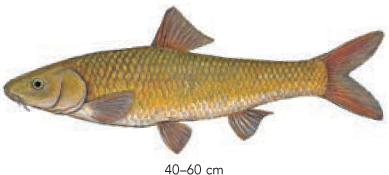
Deep olive above, sides golden, cream below. Long, pointed snout, two pairs barbels. Favours deep, rocky pools of larger tributaries and mainstreams; does well in dams. Occasionally caught by anglers. Status declining since introduction of bass. Berg, Breede rivers in southwest.
Similar
SAWFIN B. serra
Olifants system in southwest. Endangered.
1 INCOMATI CHISELMOUTH
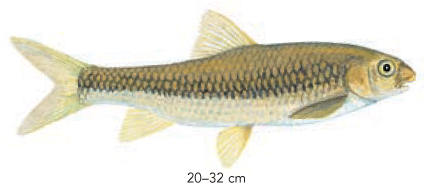
Dark olive above, light olive-yellow to creamy white below. Straight, hard-edged lower jaw, one pair short barbels. Cool, rocky, flowing water in schools of 50-100. Escarpment streams of Incomati and Pongolo river systems.
Similar
SHORTSNOUT CHISELMOUTH V. nasutus
Middle and lower Zambezi, Pungwe rivers.
PUNGWE CHISELMOUTH V. pungweensis
Pungwe and Buzi rivers in Mozambique.
Labeo umbratus
2 MOGGEL
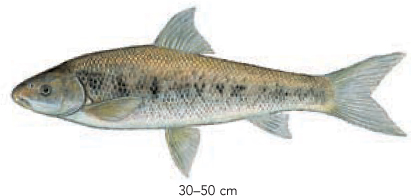
Mouth underhanging, soft, fleshy. Greyish with iridescent pink and cream mottling, off-white below, scales small. Standing or gently flowing water; thrives in dams. Orange-Vaal system, river systems in south and southeast.
Similar
ORANGE RIVER MUDFISH L. capensis
Grey. Orange-Vaal system.
TUGELA LABEO L. rubromaculatus
Tugela system.
CLANWILLIAM SANDFISH L. seeberi
Very small scales. Clanwilliam-Olifants system in southwest. Critically endangered.
Labeo altivelis
3 MANYAME LABEO
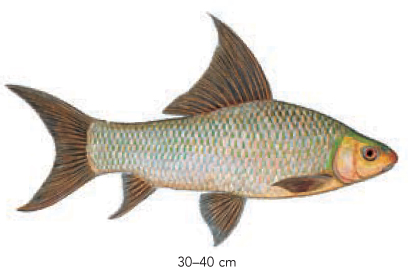
Body deep, dorsal fin large. Iridescent pinkish scales on bright green base; bright green band behind gill cover, fins deep bluish-grey. Bright red tubercles on snout. Large rivers, lakes, dams. Middle, lower Zambezi southwards to Save River.
Similar
REDNOSE LABEO L. rosae
Snout with red tubercles. Lowveld reaches of Limpopo, Incomati, Pongolo rivers.
SILVER LABEO L. ruddi
Plain silvery. Cunene, also lowveld reaches of Limpopo, Incomati.
Labeo cylindricus
4 REDEYE LABEO
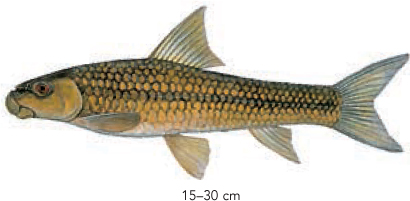
Body cylindrical or tubular, snout with prominent tubercles. Olive to yellow-green with darker band along body, eye red above. Rocky habitats, usually in running water. Okavango and Zambezi rivers southwards to Pongolo River.
Similar
PURPLE LABEO L. congoro
Greenish-grey with purple sheen. Dorsal fin high. Lowveld reaches of middle and lower Zambezi River, east coast rivers southwards to Pongolo River.
LEADEN LABEO L. molybdinus
Middle and lower Zambezi southwards to Tugela River.
UPPER ZAMBEZI LABEO L. lunatus
Dorsal fin high, crescent-shaped. Okavango River.
CUNENE LABEO L. ansorgii
Cunene River.
1 LARGEMOUTH YELLOWFISH
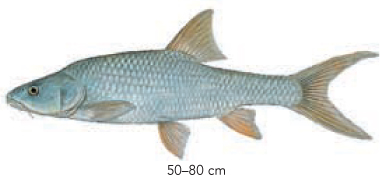
Silvery olive-grey, anal fin light orange in adult. Largestindigenous scale-bearing species. Renowned angling fish. Prefers flowing water in deep channels or below rapids, does well in dams. Mainstream and larger tributaries of Orange-Vaal system. Vulnerable.
Labeobarbus aeneus
2 SMALLMOUTH YELLOWFISH
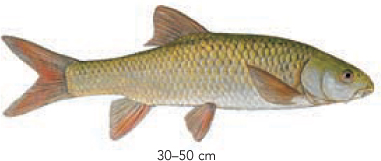
Olive-bronze above, cream below. Lips variable, from thin to fleshy. Clear-flowing waters of large rivers, dams. Important angling species. Orange-Vaal system, translocated to Limpopo and larger rivers in south.
Similar
SCALY L. natalensis
30-60 cm. Widespread from Mkuze southwards to Umtamvuna.
SMALLSCALE YELLOWFISH L. polylepis
30-46 cm. Limpopo, Incomati, Pongolo systems.
CLANWILLIAM YELLOWFISH L. capensis
30-90 cm. Clanwilliam-Olifants system in southwest. Vulnerable.
LARGESCALE YELLOWFISH L. marequensis
30-47 cm. Middle, lower Zambezi southwards to Pongolo system.
UPPER ZAMBEZI YELLOWFISH L. codringtonii
20-39 cm. Upper Zambezi, Okavango River.
Cyprinus carpio
3 CARP
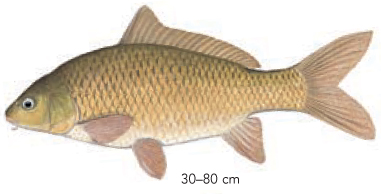
Olive-brown to rich gold, fins grey. Serrated spine in dorsal and anal fins. May be partly naked with scattered scales, or without scales. Favours large water bodies with slow-flowing or standing water. Introduced, now widespread in all except mountain and tropical areas.
Similar
Grass carp and silver carp have been introduced to farm dams and hatcheries.
Carassius auratus
4 GOLDFISH
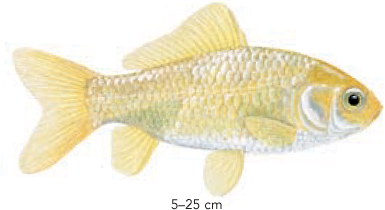
Body shape, fin form and colour variable; wild colour metallic olive-bronze. No barbels. Prefers quiet, weedy habitat. Feral populations around larger towns.
Tinca tinca
5 TENCH
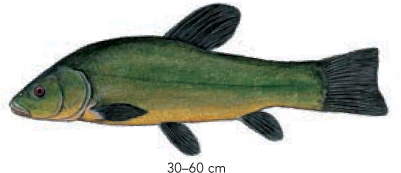
Olive-green or coppery brown to almost black, deep yellow underneath, fins black. Minute scales. Prefers deep, vegetated water in vleis, swamps. Introduced. Breede River, isolated farm dams in southwest, southeast and east.
Oncorhynchus mykiss
6 RAINBOW TROUT
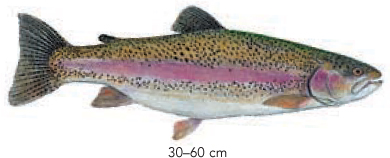
Streamlined body with very small scales. Sharp teeth. Lower jaw of mature male enlarged and hooked. Silvery or light golden with small black spots, lilac-mauve band from head to tail. Renowned angling species. Introduced. Dams and streams; cold water necessary for breeding (Jun-Sep).
Similar
BROWN TROUT Salmo trutta
Large brown and red spots on upper half. Introduced.
1 CHESSA
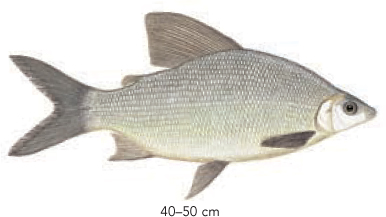
Silvery olive with sooty dorsal, caudal and anal fins, pectorals and pelvics yellowish. Fin bases covered by scales with fine teeth on free edge. Body rises steeply from behind pointed head. Large rivers, shoals over rock and sand. Middle and lower Zambezi, Buzi and Pungwe rivers.
Similar
NKUPE D. mossambicus
Deep olive, almost black.
Hemigrammocharax multifasciatus
2 MULTIBAR CITHARINE
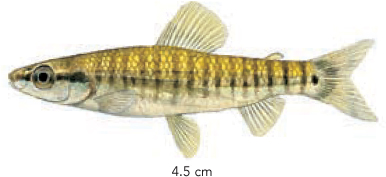
Slender body. Translucent light olive, with 16-25 dark vertical bars and a prominent spot at base of caudal fin. Vegetated margins of rivers and oxbow lagoons or shallow lakes. Cunene, Okavango, upper Zambezi, Kafue rivers.
Similar
DWARF CITHARINE H. machadoi
Caudal fin with prominent dark “eye” spot and two or three vertical bands. No adipose fin.
BROADBAR CITHARINE Nannocharax macropterus
Light olive above, white below, with irregular broad dark lateral band.
Hydrocynus vittatus
3 TIGERFISH
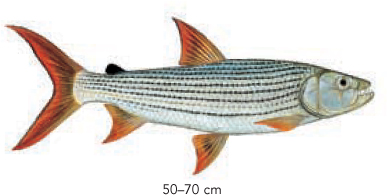
Silvery, with bluish sheen on back and series of parallel longitudinal black stripes. Adipose fin black, other fins yellow-red. Schools in warm, well-oxygenated water in larger rivers and lakes, tending to frequent surface layers. Okavango, Zambezi and lowveld reaches of east coast rivers southwards to Pongolo. Major angling gamefish.
Brycinus imberi
4 IMBERI
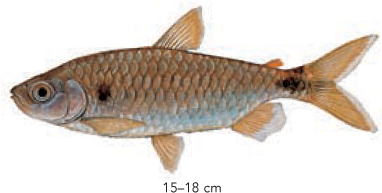
Silvery with yellowish fins, adipose fin orange, top half of eye orange. Black spot behind head, dash on caudal peduncle. Shoals in wide variety of habitats including larger rivers, pans, lagoons. East coast rivers southwards to Pongolo River.
Similar
STRIPED ROBBER B. lateralis
Prominent black caudal dash surrounded by yellow. Cunene, upper Zambezi, Okavango, Buzi rivers and St Lucia.
SILVER ROBBER Micralestes acutidens
Black tip to dorsal fin. Cunene, Okavango, Zambezi and east coast rivers southwards to Pongolo River.
SLENDER ROBBER Rhabdalestes maunensis
Bluish-green iridescent band along body, black band along base of anal fin. Cunene, upper Zambezi, Okavango rivers.
BARNARD’S ROBBER Hemigrammopetersius barnardi
Black band passes across anal fin. Lower Zambezi, Pungwe, Buzi systems.
Hepsetus odoe
5 AFRICAN PIKE
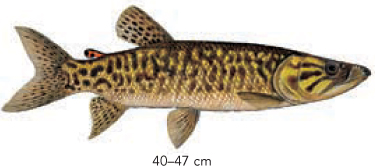
Rich brassy olive with dark brown blotches and cream underparts, adipose fin orange with black spots, three brown bands radiate behind eye. Jaws pointed, with sharp irregular teeth. Quiet, deep water, as in channels and lagoons of large floodplains. Breeding pairs guard floating foam nest in shelter of marginal vegetation. Cunene, upper Zambezi, Kafue, Okavango rivers.
1 ROCK CATFISH
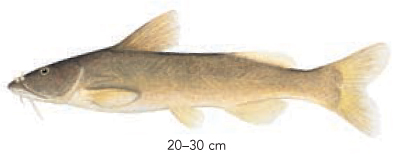
Olive-brown with scattered spots, lips fleshy, three pairs short barbels. Rocky habitats in flowing water, favours rapids. Orange-Vaal system.
Similar
ZAMBEZI GRUNTER Parauchenoglanis ngamensis
Larger (30-38 cm), 5-7 vertical lines of black spots. Upper
Zambezi and Okavango rivers.
BUZI GRUNTER Amarginops hildae
Smaller (9-11 cm). Olive-grey. Lower Buzi River.
SPOTTED ROCK CATFISH Austroglanis barnardi
Smaller (6-12 cm). Golden brown with dark brown blotches.
Tributaries of Clanwilliam-Olifants system.
CLANWILLIAM ROCK CATFISH Austroglanis gilli
Smaller (6-12 cm). Greyish to yellowish-brown, usually without prominent markings. Tributaries of Clanwilliam-Olifants system.
Amphilius uranoscopus
2 COMMON MOUNTAIN CATFISH
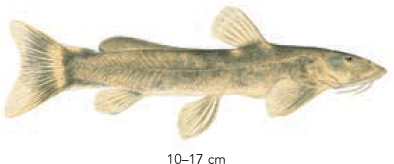
Yellowish/greyish-brown, mottled or with dark shadows or blotches. No spines in fins. Eyes on top of head. Clear flowing water in rocky habitats. Young easily mistaken for tadpoles. Okavango, Zambezi systems, east coast rivers southwards to Mkuze River.
Similar
NATAL MOUNTAIN CATFISH A. natalensis
Escarpment streams from Eastern Highlands of Zimbabwe to
Drakensberg (Umkomaas system).
SPOTTED SAND CATLET Zaireichthys rotundiceps
Across north of region from Cunene to Save River.
Schilbe intermedius
3 SILVER CATFISH
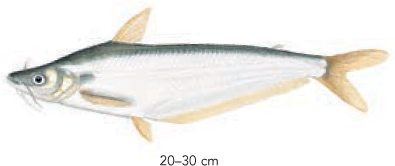
Light olive or silvery grey with yellow edges; dark chocolate mottling in clear waters. Head flattened, four pairs barbels. Anal fin long-based. Shoals in standing or slowly flowing open water with emergent or submerged vegetation. Cunene, Okavango, Zambezi systems southwards to Pongolo River.
Clarias gariepinus
4 SHARPTOOTH CATFISH

Varies from almost black to light brown, often marbled in shades of olive-green or grey; underparts white. Head large, heavy boned and flattened, jaws with bands of fine, pointed teeth, four pairs long barbels. Most widely distributed fish in Africa, naturally found as far south as Orange River system and Umtamvuna River (east coast), translocated to certain rivers in south. Favours flood-plains, large sluggish rivers, lakes, dams. Can move overland, crawling on extended pectoral spines.
Similar
Six species difficult to identify accurately, widely distributed north of Orange River.
Heterobranchus longifilis
5 VUNDU
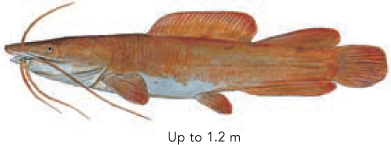
Adipose fin large. Olive-grey or reddish-brown, head and abdomen white below. Barbels reach beyond head. Within mainstream in large deep rivers, or deep pools/lakes. Largest freshwater fish in region, up to 55 kg. Important angling species. Middle and lower Zambezi River.
1 ELECTRIC CATFISH
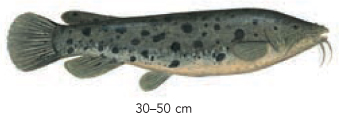
Grey above, off-white below, irregular black blotches. Head and body rounded, fleshy. Sluggish water among rocks or roots. Active at night, feeding mainly on fish stunned by electric shocks of 300-400 volts. Forms pairs, breeds in excavated cavities or holes. Middle and lower Zambezi, Pungwe, lower Save rivers.
Synodontis zambezensis
2 BROWN SQUEAKER
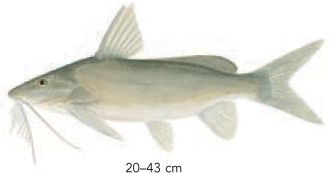
Plain olive-brown or grey. Bony skull, long, branched barbels. Common name comes from sound it makes on being removed from the water. Large sharp dorsal and well-barbed pectoral fin spines can be locked in place to form defence mechanism. Sandy stretches of flowing rivers. Middle, lower Zambezi River southwards to Pongolo system.
Similar
The cloudy squeaker (S. nebulosus), with large brown or yellowish blotches, occurs in same area. Seven further species, difficult to identify accurately. Occur in Cunene, upper Zambezi, Okavango rivers.
Chiloglanis pretoriae
3 SHORTSPINE SUCKERMOUTH
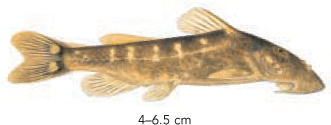
Dark brown with small lighter patches, series of vertical spots along body. Sharp spines in dorsal and pectoral fins. Mouth forms sucker disc, used to cling onto rocks or plants. Fast-flowing rocky streams or rapids and rocky stretches in larger rivers. Incomati, Limpopo, middle and lower Zambezi, Pungwe, Buzi rivers.
Similar
Seven further species, difficult to identify accurately: five in Pongolo-Incomati-Limpopo, one in Okavango, one in Cunene, Zambezi, Pungwe and Buzi rivers.
Galaxias zebratus
4 CAPE GALAXIAS

Translucent pale brown with or without darker blotches or bars, internal organs visible in living specimens. Hardy, favours gentle currents within shelter of banks. Coastal streams and rivers from south coast to Clanwilliam-Olifants system.
Aplocheilichthys johnstoni
5 SLENDER TOPMINNOW
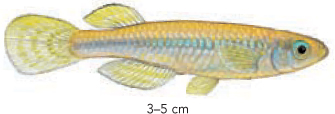
Translucent yellowish-green with silvery blue iridescence, iris of eye silvery blue. Inshore well-vegetated habitats, often in very shallow water, small shoals near surface. Cunene, Okavango, Zambezi, Limpopo rivers.
Similar
NATAL TOPMINNOW A. myaposae
Maputaland, Kosi to Umlazi.
Aplocheilichthys katangae
6 STRIPED TOPMINNOW
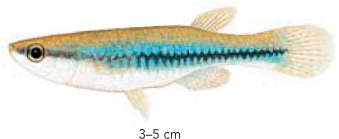
Zigzag black band along body, white below, scattered midbody scales iridescent blue-turquoise. Dense marginal vegetation of streams and rivers. Cunene, Okavango, Zambezi, Maputaland.
Aplocheilichthys hutereaui
7 MESHSCALED TOPMINNOW
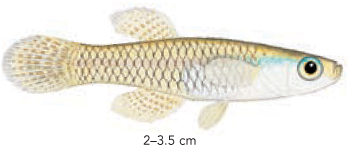
Translucent yellowish, iris of eye turquoise. Sooty pigment on scale edges gives mesh effect. Restricted to swamps and flood-plains. Upper Zambezi, Okavango, Buzi, Pungwe rivers.
1 SPOTTED KILLIFISH
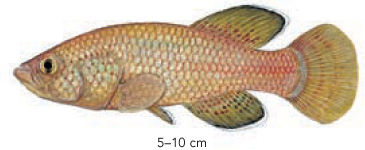
Female plain fleshy brown, male brightly patterned red or blue; red spots on head. Temporary rainpools or riverine floodplains. Life cycle is completed within a year. Eggs can endure drying out, and hatch the following rainy season. Eastern coastal plain southwards to Mkuze River.
Similar
BEIRA KILLIFISH N. kuhntae
Floodplains of the Pungwe near Beira.
TURQUOISE KILLIFISH N. furzeri
Pans in Gona-re-Zhou Game Reserve, Zimbabwe.
RAINBOW KILLIFISH N. rachovii
Marshes on coastal plain near Beira, pans in Kruger NP.
Micropterus salmoides
2 LARGEMOUTH BASS
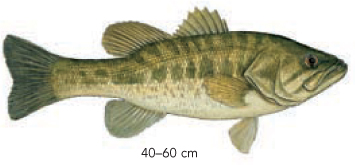
Olive-green above, light green on flanks, series of dark olive-green bars forming band along body, two or three stripes radiate behind eye. End of jaw extends behind eye. Clear standing or slow-flowing water, thrives in farm dams. Popular gamefish. Widely introduced throughout region.
Similar
SMALLMOUTH BASS M. dolomieu
Narrow vertical bars on body. Jaw ends below eye.
SPOTTED BASS M. punctulatus
Diamond-shaped bars along midbody, spotted below midline.
Lepomis macrochirus
3 BLUEGILL
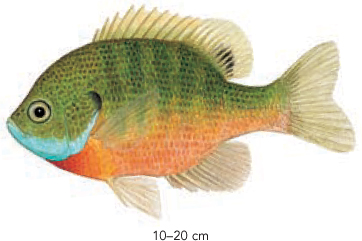
Iridescent green-blue with vague vertical bands along body. Chest orange in breeding male. Blunt black projection on gill cover. Quiet well-vegetated waters. Male constructs nest and guards eggs. Introduced to coastal drainages in south, midlands in east, less common further north.
Pseudocrenilabrus philander
4 SOUTHERN MOUTHBROODER
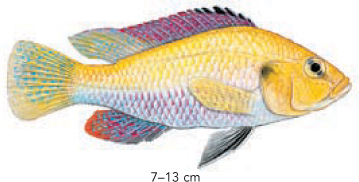
Female light brown with black vertical bars and light yellowish fins. Male body a mesh of iridescent light blue and yellow with oblique bar through eye and iridescent blue lower jaw. Anal fin with orange tip. Caudal fin rounded. Wide variety of habitats from flowing water to lakes, isolated sinkholes. Breeds early spring to late summer. Male defends territory and constructs nest. Eggs are mouthbrooded by female. Orange River and east coast northwards throughout region.
Similar
CUNENE DWARF BREAM Orthochromis machadoi
Dark bars from eye to mouth and from eye across top of gill cover. Cunene system.
EASTERN BREAM Astatotilapia calliptera
Olive-green with 8-9 olive vertical bars, dark bar from eye to corner of mouth, red “egg-spots” on anal fin. Lower Zambezi to lower Save system.
Hemichromis elongatus
5 BANDED JEWELFISH
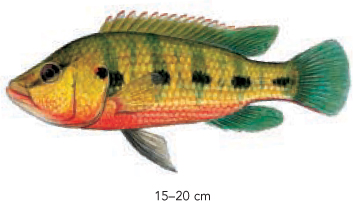
Body green above, red below, 4-5 black vertical bars. Two enlarged conical teeth in front of upper jaw. Near shores in rivers, permanent floodplain lagoons with clear water. Upper Zambezi and Okavango rivers.
1 CANARY KURPER
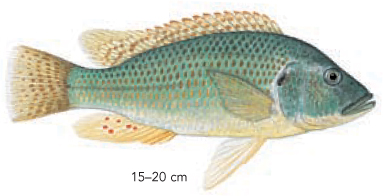
Olive-brown above, scales with orange-red base, mature male with bright yellow chest, membranes of dorsal and caudal fins with rows of dark brown spots, anal fin with orange “egg-spots”. Standing or slow-flowing pools. Female mouthbroods young. Tributaries of Limpopo River.
Similar
ORANGE-FRINGED LARGEMOUTH C. brevis
Dorsal fin with orange spots and tips, anal fin of male with two rows of large orange spots. Komati-Incomati system.
ZAMBEZI BREAM Pharyngochromis acuticeps
Okavango, upper and middle Zambezi, upper Save rivers.
Sargochromis giardi
2 PINK BREAM
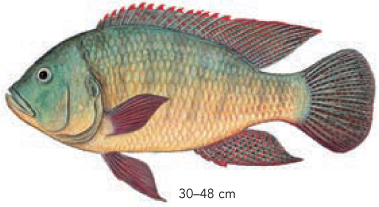
Robust body and head. Greyish-green head and back, flanks and underparts creamy yellow, fins dark grey with red margins and dark red spots, anal fin with rows of bright yellow orange-centred “egg-spots” along membranes. Deep river channels, floodplain lagoons. Female mouthbroods young. Cunene, upper Zambezi, Okavango rivers.
Similar
RAINBOW BREAM S. carlottae
Concave head profile. Upper Zambezi, Okavango rivers.
GREEN BREAM S. codringtoni
Green colour distinctive. Upper Zambezi, Okavango rivers.
DEEPCHEEK BREAM S. greenwoodi
Deep cheek distinctive. Upper Zambezi, Okavango rivers.
Serranochromis robustus
3 NEMBWE
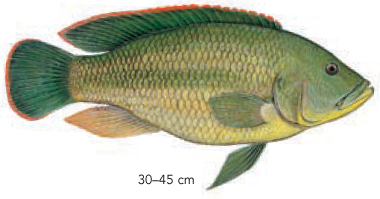
Large mouth with conical teeth. Olive to bright green, with deep olive band along midbody, anal fin of male with small orange “egg-spots”, orange margin to dorsal and caudal fins. Channels and lagoons. Breeds in summer, nesting along vegetated edges of mainstreams, female mouthbroods young. Upper Zambezi and Okavango rivers; translocated to Swaziland and southwards.
Similar
PURPLEFACE LARGEMOUTH S. macrocephalus
Anal fin of male with large orange “egg-spots”. Okavango, Cunene rivers.
BROWNSPOT LARGEMOUTH S. thumbergi
Blue margin to dorsal and caudal fins. Cunene, upper Zambezi, Okavango rivers.
Serranochromis meridianus
4 LOWVELD LARGEMOUTH
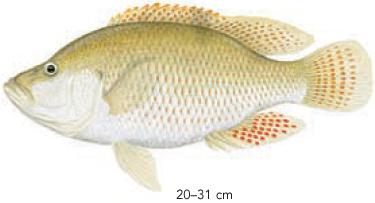
Olive-brown to yellow, fins yellowish with dark red spots. Male dorsal fin edged with yellow, anal fin with numerous “egg-spots”. Prefers standing or slow-flowing pools with marginal vegetation. Male clears a nest, female mouthbroods young. Sabie-Sand tributary of Incomati River, coastal lakes of Maputaland and southern Mozambique.
Similar
HUMPBACK LARGEMOUTH S. altus
Olive-brown. Upper Zambezi, Okavango rivers.
THINFACE LARGEMOUTH S. angusticeps
Head with red spots. Cunene, upper Zambezi, Okavango rivers.
1 BANDED TILAPIA
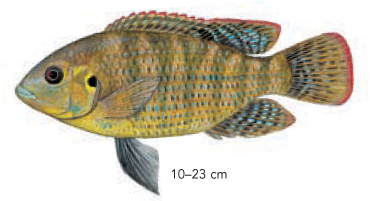
Deep olive-green with 8-9 vertical bars on body and two bars between the eyes. “Tilapia spot” on soft dorsal fin. Prefers quiet or standing waters. Male constructs a nest in which eggs are guarded by both parents. Orange River northwards and east; widely translocated south of Orange River.
Similar
OKAVANGO TILAPIA T. ruweti
Dorsal, caudal and anal fins spotted, margin of dorsal a thin blue, white and red band. Upper Zambezi, Okavango rivers.
REDBREAST TILAPIA T. rendalli
Bright red throat and chest. Cunene, Okavango, Zambezi southwards to Pongolo River. Widely introduced in KwaZulu-Natal.
Oreochromis mossambicus
2 MOZAMBIQUE TILAPIA
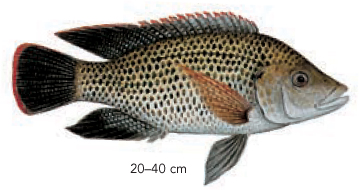
Silvery olive to deep blue-grey, dorsal and caudal fins with red margins. Breeding male turns grey-black with white lower head and throat. Occurs in all but fast-flowing waters. Male constructs saucer-shaped nest, female mouthbroods. East coast rivers from lower Zambezi system to Bushmans system in southeast. Widely dispersed inland, south and southwest.
Similar
BLACK TILAPIA O. placidus
Frequently occurs with Mozambique tilapia in north. Deeper bodied, breeding male sooty grey with black throat and fins, black head markings.
Sandelia capensis
3 CAPE KURPER
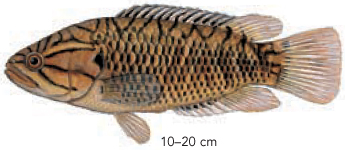
Yellow or golden brown with black spots and wavy bands, head with black stripes radiating from eyes. Hardy, prefers slow-flowing water with plant or root cover. Male defends breeding territory and guards the scattered eggs. Southern coastal rivers from Algoa Bay to Verlorenvlei.
Similar
EASTERN CAPE ROCKY S. bainsii
Olive or grey-brown. Nahoon, Buffalo, Keiskamma, Great Fish and Kowie systems in southeast.
Ctenopoma multispine
4 MANYSPINED CLIMBING PERCH
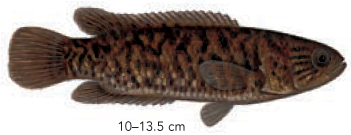
Spines on edge of gill cover. Brown with irregular dark bars and spots. Vegetated backwaters, floodplain lagoons, swamps. Can endure warm, stagnant water; air-breathing organ enables it to leave the water and move overland during wet weather or at night. Okavango, lower Zambezi rivers, northeastern coastal plain southwards to Maputaland.
Limnothrissa miodon
5 KAPENTA
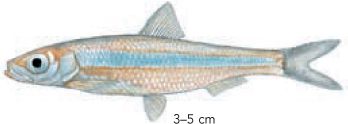
Transparent with silvery band from head to tail. Large shoals rise in water column and disperse at night, congregating and descending during day. Introduced to Lake Kariba, where it is an important commercial catch; also present in Lake Cahora Bassa.
Kneria auriculata
6 SOUTHERN KNERIA
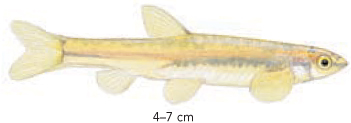
Translucent brown with flecks and blotches on upper body, scales minute. Shoals in pools of small, clear rocky streams. Upland streams of lower Zambezi, Pungwe, Buzi, Save rivers; also in Crocodile River (Incomati system).